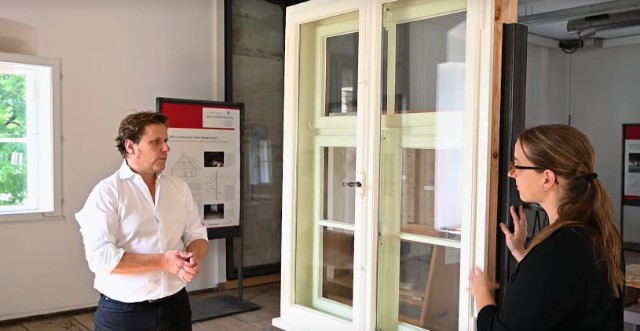
Privacy warning
With the click on the play button an external video from www.youtube.com is loaded and started. Your data is possible transferred and stored to third party. Do not start the video if you disagree. Find more about the youtube privacy statement under the following link: https://policies.google.com/privacyVideo on the research project: Retrofitting historical glass panes and windows to save energy
Content and objectives
As far as heritage conservation is concerned, in our view every single part of a historical building is worth preserving. Windows and glass panes, which still characterize façades today, are an essential part of a building’s historical appearance.
The first focus of the project is on assessing the life cycles of glass panes. Key criteria include resource consumption, primary energy input and recycling rates. The latter deserves special attention. Due to different manufacturing processes and qualities of the raw materials used, the composition of historical glass panes is generally unknown, especially with regard to heavy metals. It is therefore impossible to recycle them in modern production chains without prior treatment. The result is large quantities of waste glass.
The project then focuses on testing and evaluating by way of measurements a method for retrofitting existing windows by mounting adaptive windows in front of them. The test site for this is the Alte Schäfflerei in Benediktbeuern. The advantage of retrofitting would be to save resources by preserving the existing windows. Heat losses would also be minimized, which in turn would lower energy requirements and reduce the CO2 footprint.
The third aspect of the project is concerned with preserving old panes by exploring ways to slightly modify their structural and surface properties. This includes recommendations for modifying the structure of the frames and the application of films and coatings.
The core questions dealt with in the project are:
What makes more sense: to retrofit existing windows and save resources or replace them?
What are the options for preserving them?
The project is thus closely related to the UN’s Sustainable Development Goals (SDGs), not only in terms of preserving cultural heritage, but also with regard to using natural resources efficiently.
The aim is to develop solutions for retrofitting glass panes and windows made before 1960 so that they meet today's energy and monument conservation criteria and can still to be used. Key fields of activity include the development of contemporary designs and their experimental installation and metrological evaluation in the Alte Schäfflerei of the Benediktbeuern Monastery.
For the historical glass manufacturing processes, not only were the production sites and, where appropriate, the respective sources of raw materials identified, but also process sequences were compiled in order to make life cycle assessments. The types of fuel used as well as furnace design also played a decisive role.
The research results are supplemented by a manual. At the end of the project, the manual will outline a suitable quality assurance method for handling old buildings, taking into account aspects of resource conservation and life cycle assessment. The ability to transfer the results to other types of buildings plays a key role in the project. Finally, the findings will be prepared in an educational manner at the Fraunhofer Center in Benediktbeuern and presented to the general public in visual format.
Results
Here you can find the research results in the form of a Manual on retrofitting glass panes and windows in historical buildings to save energy as a contribution to climate protection.
Closing conference
A digital closing event for the project took place on 17 June 2021. The invitation to the final conference can be found here: link
Program:
- Welcome speech and greetings
- Presentation of the manual “Retrofitting glass panes and windows in historical buildings to save energy as a contribution to climate protection”
- “Überblick zu historischen Glasherstellungstechniken”, Centre for Heritage Conservation Studies and Technologies (KDWT), University of Bamberg
- “Lebenszyklusberechnungen für historische Gläser und Glasfenster und deren energetische Ertüchtigung”, Fraunhofer Institute for Building Physics Stuttgart
- “Historische Glasherstellungstechniken und ihre Zeugnisse in Baudenkmal”, Centre for Heritage Conservation Studies and Technologies (KDWT), University of Bamberg
- “Fenster und Gläser in der denkmalpflegerischen Praxis”, Bavarian State Office for the Preservation of Historical Monuments, Building Archives Thierhaupten
- “Denkmalgerechte, energetische Ertüchtigung von historischen Fenstern am Beispiel der Alten Schäfflerei”, Fraunhofer Institute for Building Physics Holzkirchen
- “Erhaltung und energetische Ertüchtigung von Bestandsfenstern und historischen Gläsern - Vorstellung von beispielhaften Lösungen für die Erweiterung von bestehender 1-Scheiben-Verglasung in ein Verbund-Isolierglas”, Holzmanufaktur Rottweil
- “Bauphysikalische Untersuchungen an Modelllösungen zur energetischen Sanierung historischer Fenster im Fraunhofer-Zentrum für energetische Altbausanierung und Denkmalpflege Benediktbeuern”, Fraunhofer Institute for Building Physics IBP Holzkirchen
